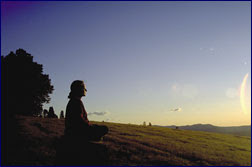
"Concentration it is that awakens our powers and channels them, dissolving obstacles in our path, literally attracting opportunities, insights, and inspirations. In many ways, subtle as well as obvious, concentration is the single most important key to success.
Make yourself comfortable, sitting upright, with a straight spine. With your eyes closed, look at the point midway between the eyebrows on your forehead.
Inhale slowly, counting to eight. Hold the breath for the same eight counts while concentrating your attention at the point between the eyebrows. Now exhale slowly to the same count of eight. Repeat three to six times.
After inhaling and exhaling completely, as the next breath comes in, mentally say Hong (rhymes with song). Then, as you exhale, mentally say Sau (rhymes with saw). Hong Sau means 'I am He' or 'I am Spirit'. Make no attempt to control your breathing, just let its flow be completely natural. Try to feel that your breath itself is silently making the sounds of Hong and Sau. Initially try to feel the breath at the point where it enters the nostrils.
Be as attentive as possible. If you have difficulty feeling the breath, you can concentrate, for a while, on the breathing process itself, feeling your diaphragm and chest expanding and contracting.
Gradually as you become more calm, try to feel the breath higher and higher in the nose. Be sure that your gaze is kept steady at the point between the eyebrows throughout your practice. Don't allow your eyes to follow the movement of the breath. If you find that your mind has wandered, simply bring it back to an awareness of the breath and the mantra.
Some Tips to Help Your Meditation
Controlling Your Breath At no time during the practice of this technique should you make any effort to control the breath. Let it flow naturally. Gradually, you may notice that the pauses between the inhalation and exhalation are becoming longer. Enjoy these pauses, for they are a glimpse of the deep peace state of advanced meditation. As you grow very calm you may notice that the breath is becoming so shallow (or the pauses so prolonged) that it hardly seems necessary to breathe at all.
How Long to Practice The amount of time you practice is entirely up to you but end your practice of the technique by taking a deep breath, and exhaling three times. Then, keeping your mind focused and your energy completely internalized and try to feel peace, love and joy within your self. Sit for at least five minutes enjoying the deeply relaxed state you are in.
Where to Meditate If possible, set aside an area that is used only to meditate. This will create a meditative mood. A small room or closet is ideal as long as it can be well ventilated. Your area can be kept very simple—all you really need is a chair or small cushion to sit on.
Posture for Meditation There are many ways of sitting that are equally good. You can sit either in a straight-backed chair or on the floor in any of several poses. Two things, however, are essential: Your spine must be straight, and you must be able to relax completely.
Eye Position Focus your attention at the point between the eyebrows. This area, called "the spiritual eye," is a center of great spiritual energy. Your eyes should be closed and held steady, and looking slightly upwards, as if looking at a point about an arm's length away and level with the top of your head.
Would you like to know more?
This is an abbreviated explanation of the Hong-Sau technique of concentration taken from Lessons in Meditation from the Ananda Course in Self-Realization. It is technique using the mantra Hong-Sau and has been practiced by students of yoga for millennia. Such techniques have a scientifically proven effect on the brain and body, and are also spiritually very helpful.
Sunday, October 14, 2007
Meditation
Posted by
tanakwagu
at
Sunday, October 14, 2007
![]()
Subscribe to:
Post Comments (Atom)

No comments:
Post a Comment